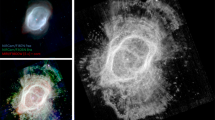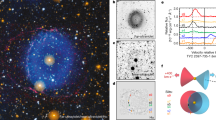Abstract
TT Arietis, one of the brightest cataclysmic variables, mv∼10.2→11.0, is usually classed as a novalike variable, but after a recent dip in brightness to mv∼14.5, Krautter et al.1 suggested it to be a dwarf nova in an extended high state. Photometric light curves2–4 generally show a sinusoidal light variation with a period of 0.1329 days and no eclipses5. Cowley et al.6 have measured radial velocity curves and find a period of 0.13755 days. We have made7 IR measurements of the system from which we deduce a distance for TT Ari of 100±20 pc based on a colour change for the system from V to K of +0.4 while the system is faint to V − K = −0.17 when brighter. The red colour is caused by dilution of the primary 2.2-µm light by the light of the secondary, giving mK = 11.75+0.45−0.25 for the secondary star; Bailey's method8 then leads to the distance. The sinusoidal light variations have generally been interpreted as due to a hot spot on the edge of an accretion disk. Since good quality IUE spectra can be made with exposure times of about 15 min, we decided to observe as many IUE spectra as possible round the binary period with a view to studying the behaviour of the hot spot at UV wavelengths. We now report that the variations at these and X-ray wavelengths round the orbital cycle rule out a hot spot/accretion disk model for TT Ari. Instead we propose that it has a magnetized white dwarf primary rotating with the photometric period of 0.1329 days.
This is a preview of subscription content, access via your institution
Access options
Subscribe to this journal
Receive 51 print issues and online access
$199.00 per year
only $3.90 per issue
Buy this article
- Purchase on Springer Link
- Instant access to full article PDF
Prices may be subject to local taxes which are calculated during checkout
Similar content being viewed by others
References
Krautter, J. et al. Astr. Astrophys. 98, 27–29 (1981).
Smak, J. & Stepien, K. Non-Periodic Phenomena in Variable Stars (ed. Detre, L.) 355–359 (Academic, Budapest, 1969).
Mardirossian, F. et al. Astr. Astrophys. 85, 29–35 (1980).
Sztano, M. Inf. Bull Variable Stars No. 1710 (1979).
Smak, J. & Stepien, K. Acta astr. 25, 379–381 (1975).
Cowley, A. P., Crampton, D., Hutchings, J. B. & Marlborough, J. M. Astrophys. J. 195, 413–421 (1975).
Jameson, R. F., Sherrington, M. R. & King, A. R. Mon. Not. R. astr. Soc. 455–462 (1982).
Bailey, J. A. Mon. Not. R. astr. Soc. 197, 31–39 (1981).
Jensen, K. et al. Bull. Am. astr. Soc. 13, 818 (1981).
Frank, J., King, A. R. & Lasota, J. P. Mon. Not. R. astr. Soc. (in the press).
Patterson, J., Williams, G. & Hiltner, W. A. Astrophys. J. 245, 618–623 (1981).
Hatchett, S., Buff, J. & McCray, R. Astrophys. J. 206, 847–860 (1976).
Felsteiner, J. & Opher, R. Astr. Astrophys. 46, 189–195 (1976).
Raymond, J. C. et al. Astrophys. J. Lett. 230, L95–L98 (1979).
Stockman, H. S., Liebert, J. & Moore, R. L. Pap. Santa Cruz Summer Workshop on Cataclysmic Variables (1981).
Tapia, S., Priedhorsky, W. & Kzreminski, W. Pap. at the Summer Workshop on Cataclysmic Variables (1981).
Bailey, J. & Ward, M. Mon. Not. R. astr. Soc. 196, 425–434 (1981).
Author information
Authors and Affiliations
Rights and permissions
About this article
Cite this article
Jameson, R., Sherrington, M., King, A. et al. UV observations of TT Arietis and the magnetic rotator hypothesis. Nature 300, 152–155 (1982). https://doi.org/10.1038/300152a0
Received:
Accepted:
Issue Date:
DOI: https://doi.org/10.1038/300152a0
This article is cited by
Comments
By submitting a comment you agree to abide by our Terms and Community Guidelines. If you find something abusive or that does not comply with our terms or guidelines please flag it as inappropriate.



